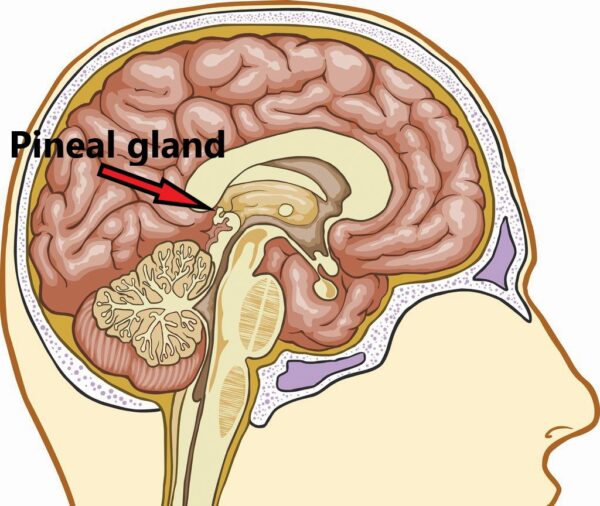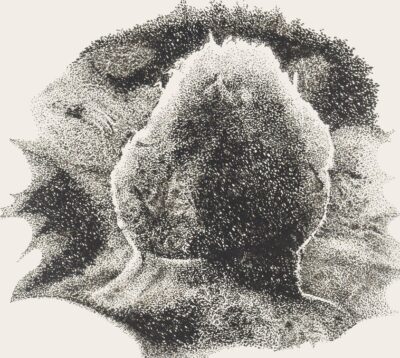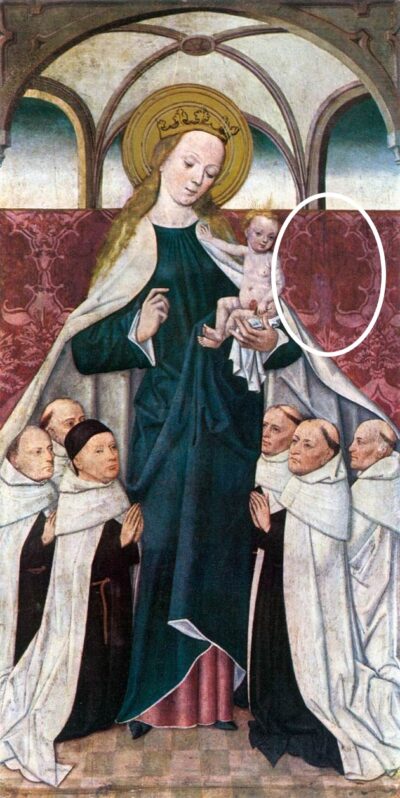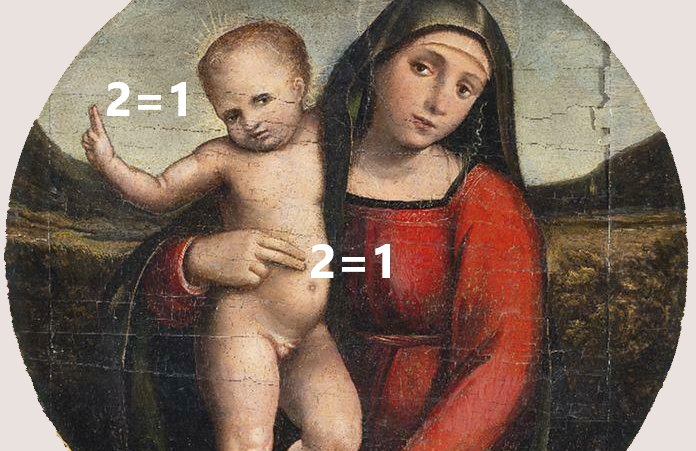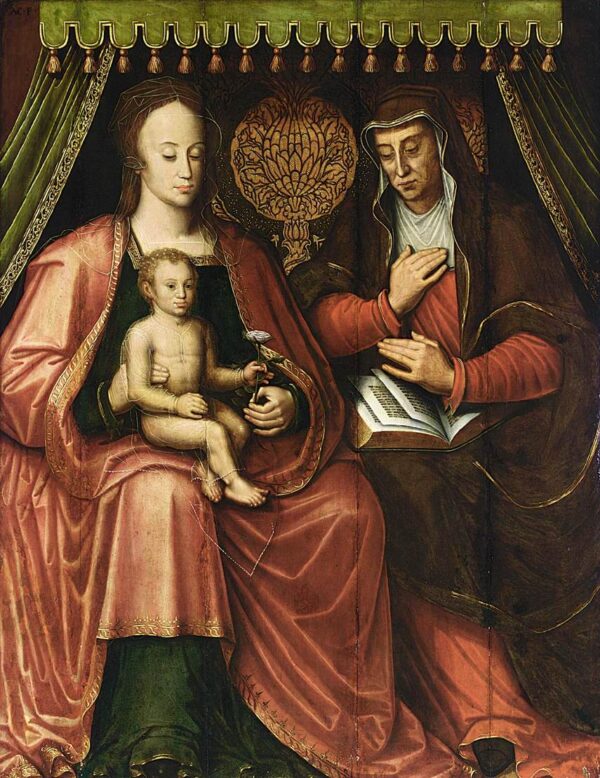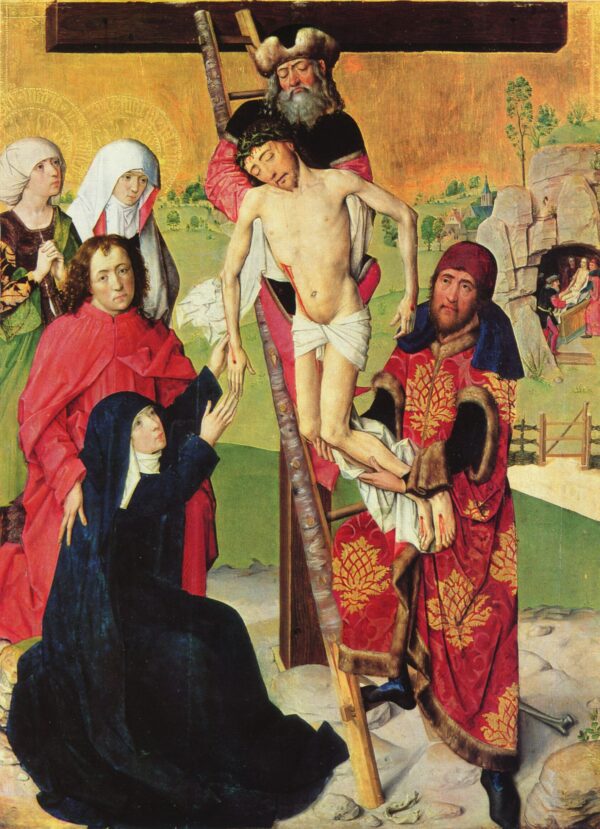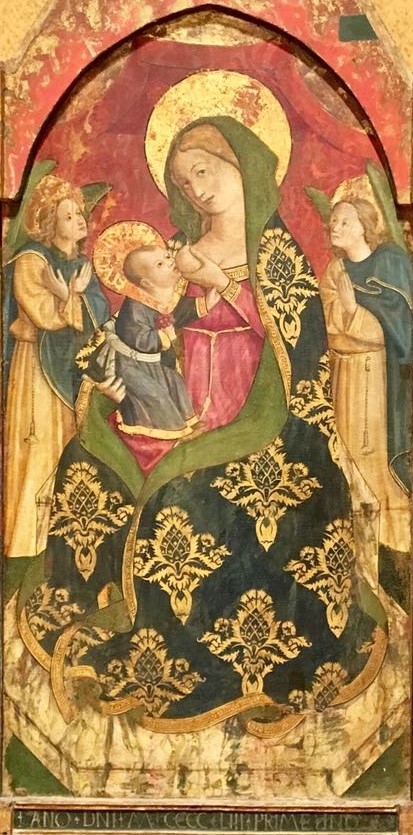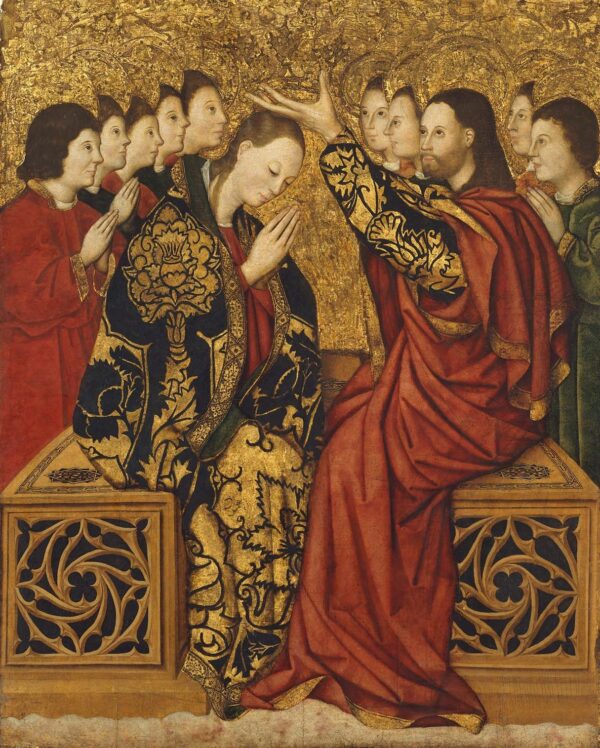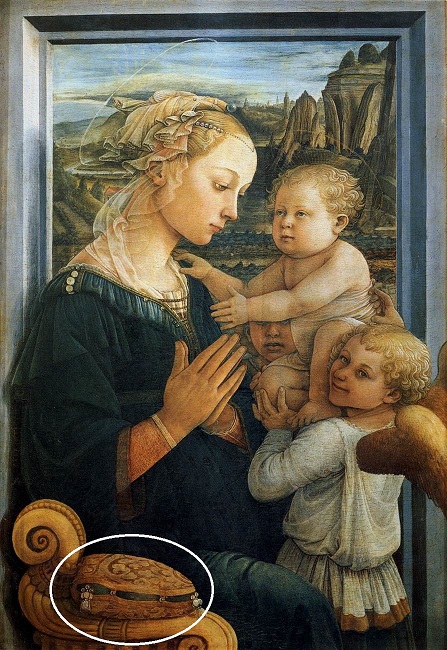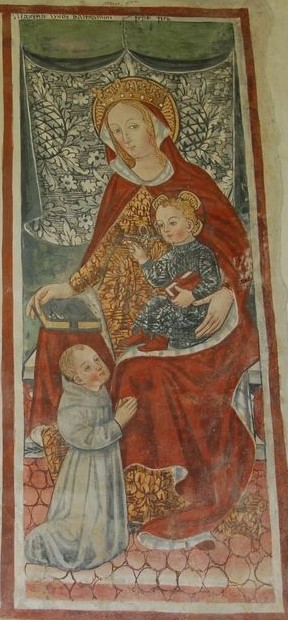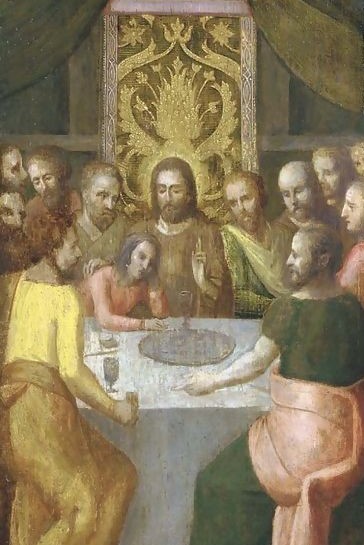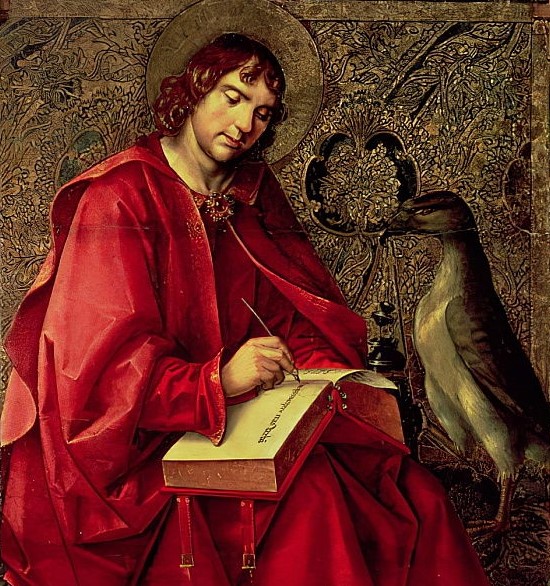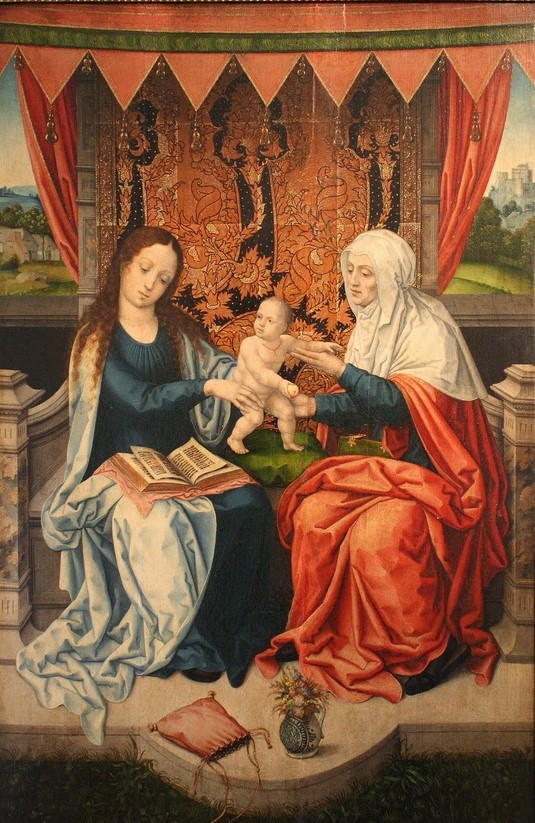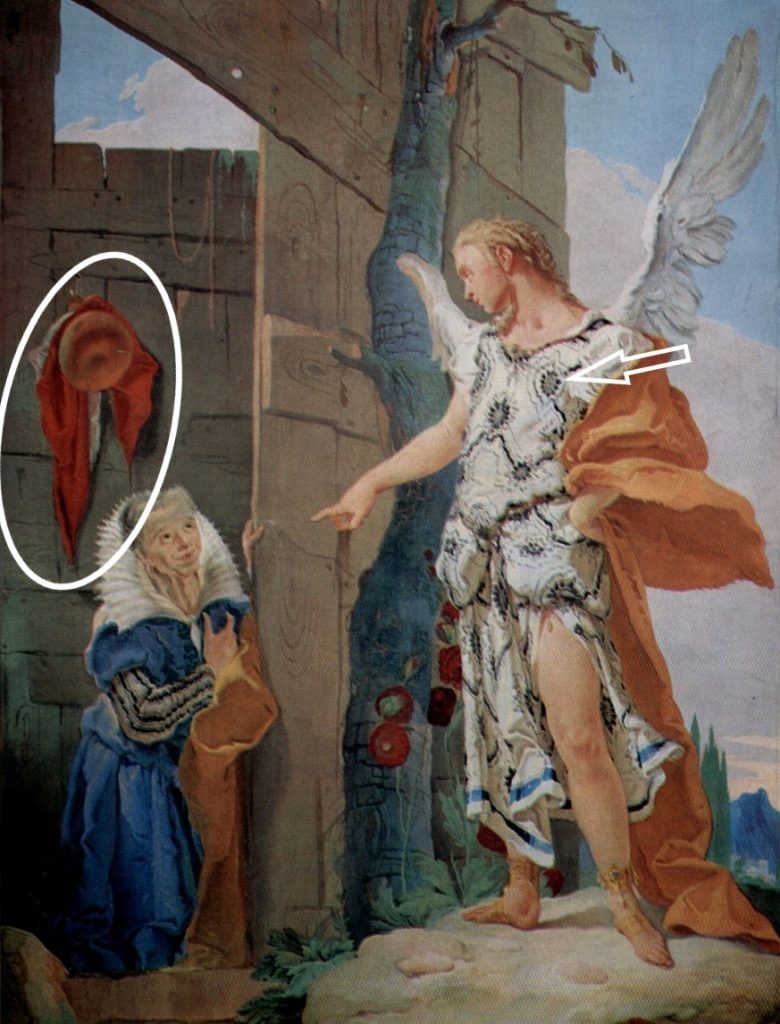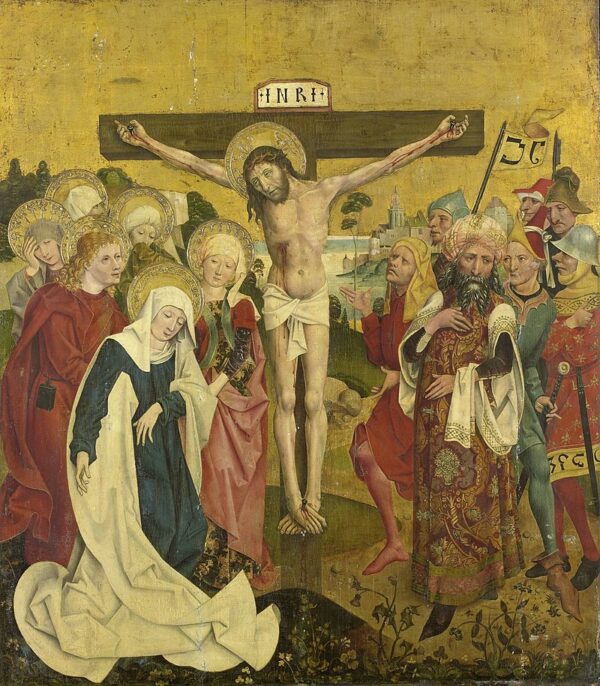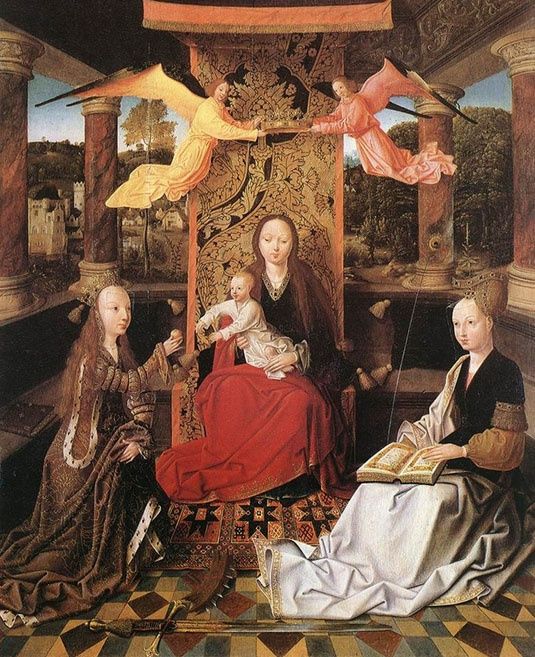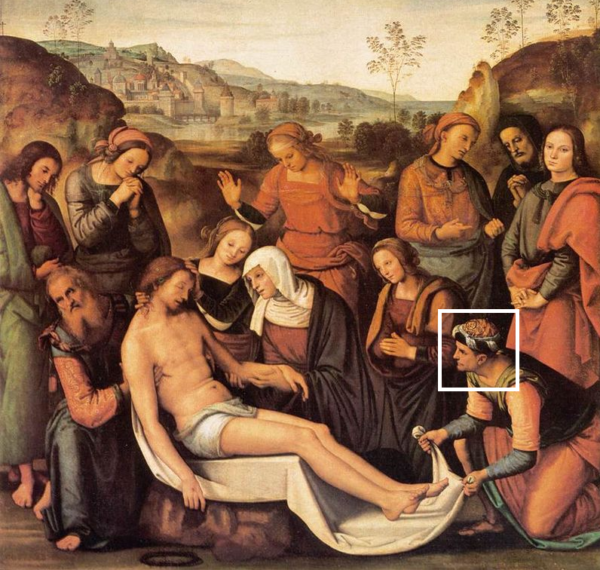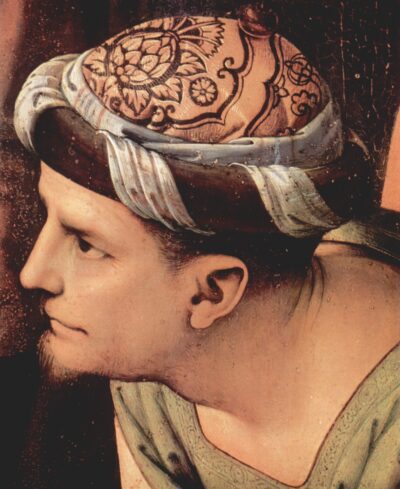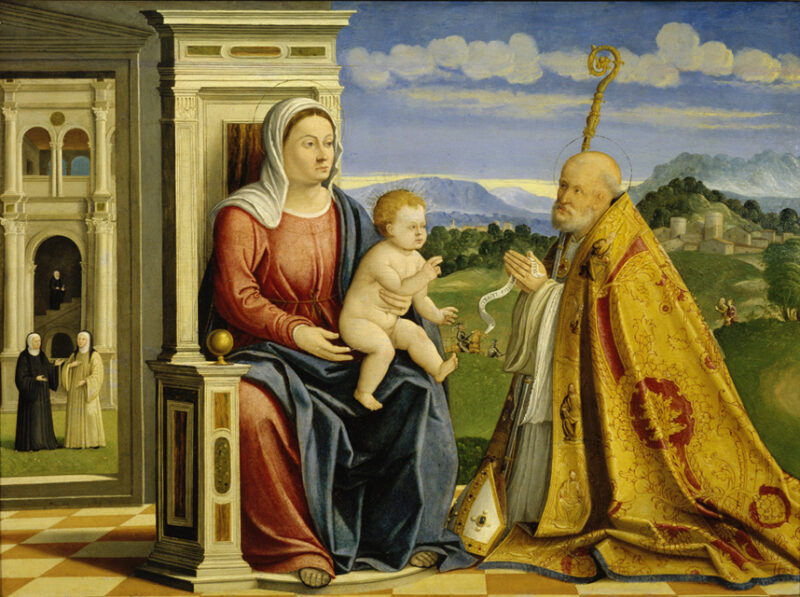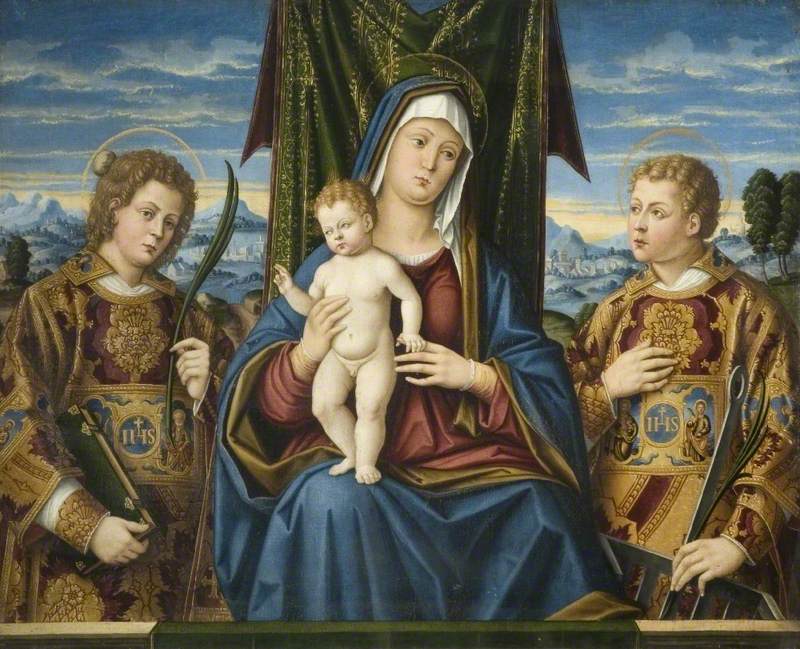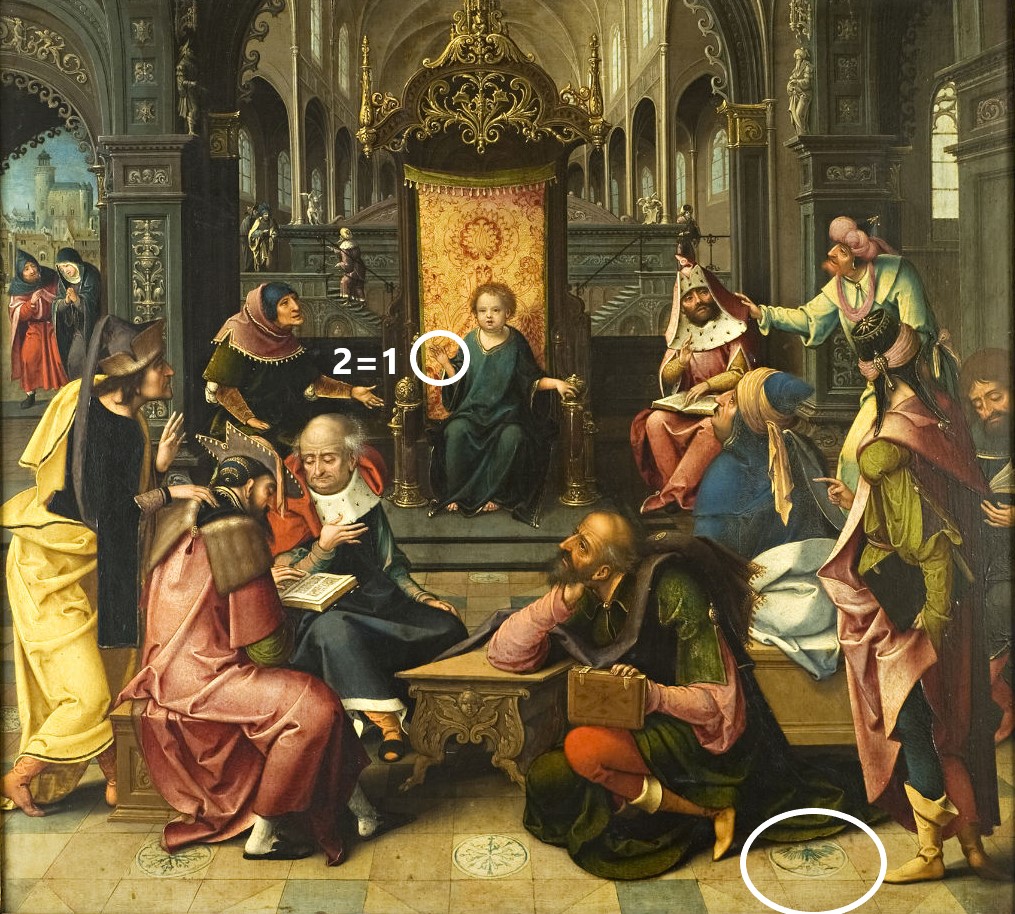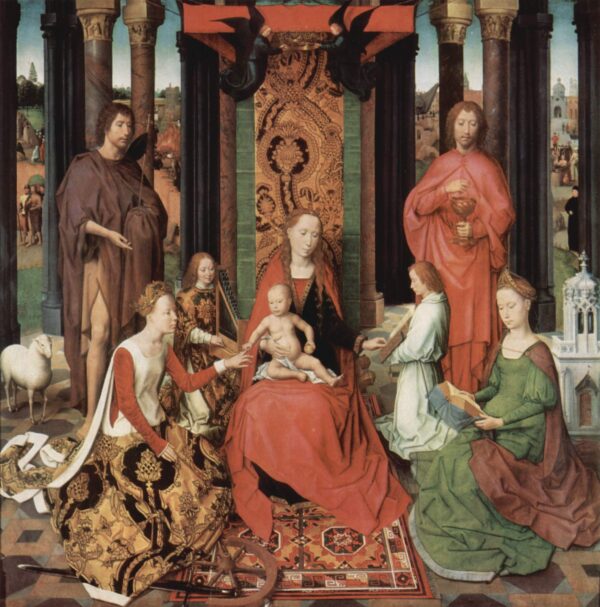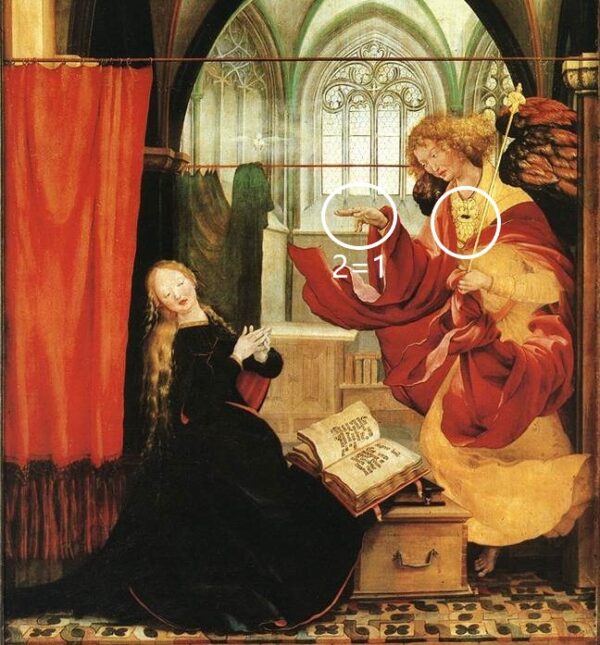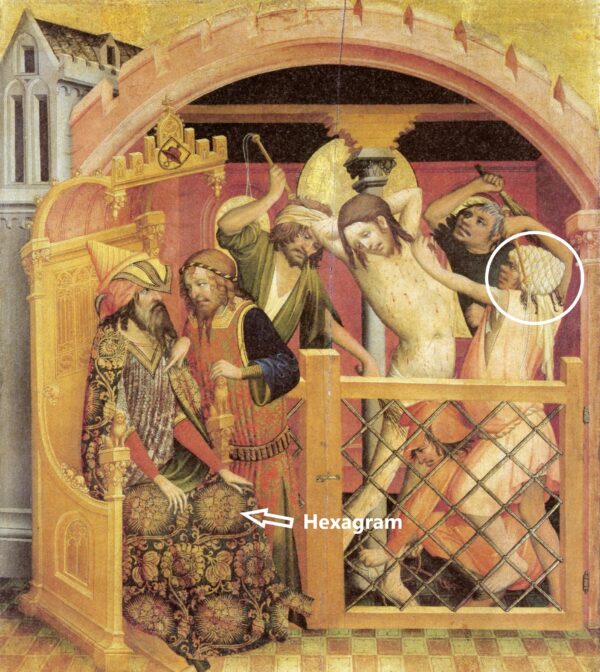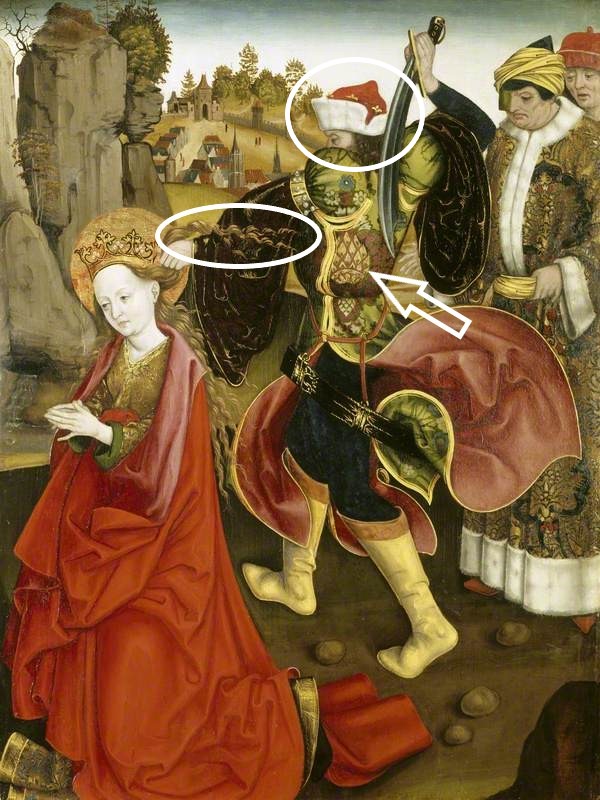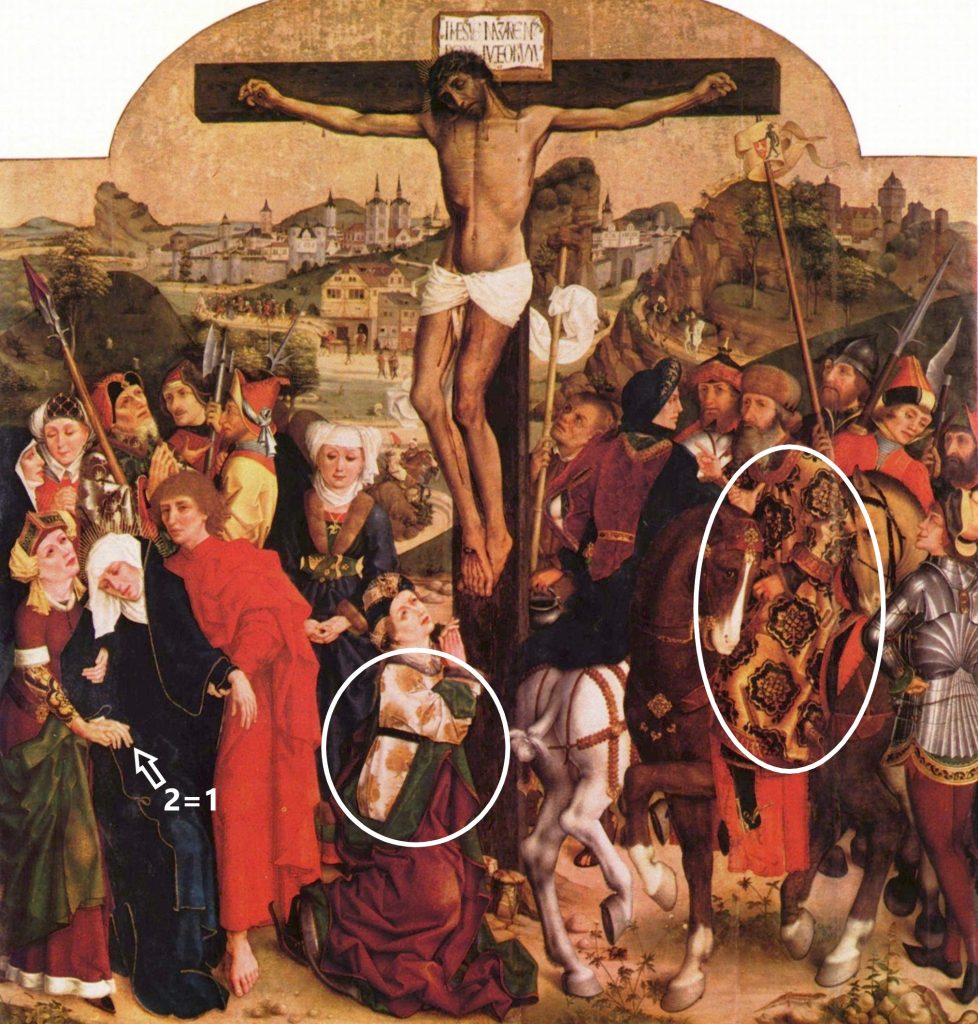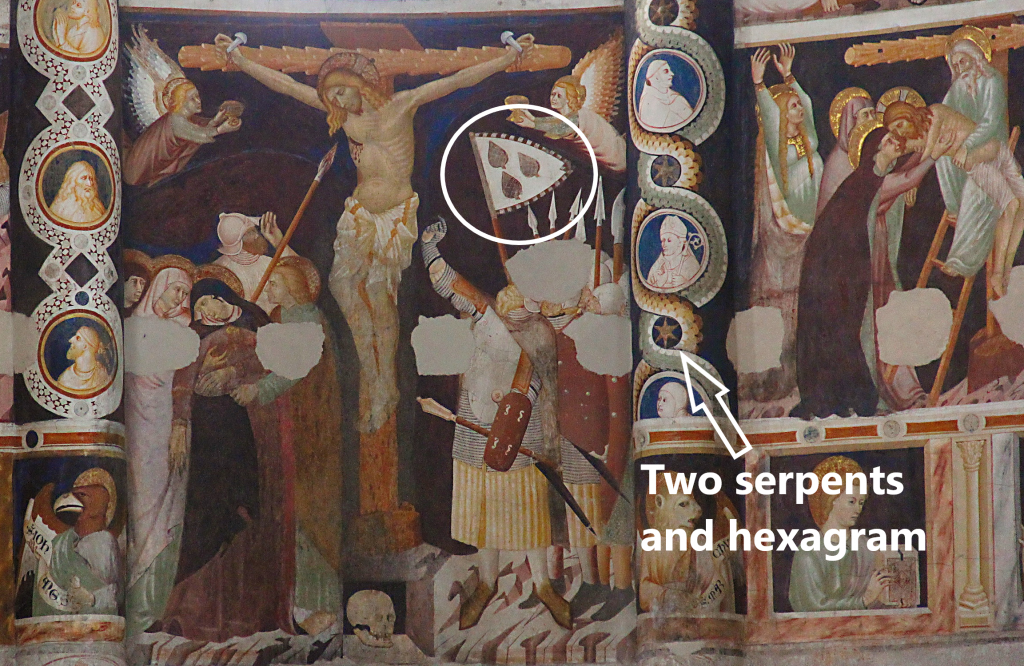Examples from Christian art
CLICK ON THE IMAGES FOR AN ENLARGEMENT
Throughout the ages there have always been initiates, artists and mystics who knew that Jesus was not born as ‘the Son of God’, but had experienced a kundalini awakening, after which he was one with his Divine Father. The Gospel writers have hidden this spiritual truth in their texts in inventive ways, including the use of imagery and wordplay (see my books). Because of the rigid attitude of the church, the truth could not be spoken aloud, but underground, through esoteric groups such as the Freemasons, it found its way onto the canvas.
THE PINE CONE, a symbol for the pineal gland, veiled in countless paintings, must tell us that all events in the life of Jesus – his birth, baptism, stations of the cross, death and resurrection – are metaphors for inner processes, driven by the kundalini energy. The message for us: in our pelvis is a source of divine energy that, when awakened, will initiate in us the same spiritual transformation process as Jesus experienced.
THE SIGN OF THE SACRED MARRIAGE (two fingers together: 2=1) is incorporated in many paintings, in one form or another, often in combination with other esoteric symbolism. This hand gesture refers to a fusion of the polar energies/duality, and with this to a process of kundalini awakening.
Carlo Crivelli, 1472.
Harrowing of Hell, Alessandro Allori, 1584. Read about the deeper meaning of the “Descent into Hell” in my book “John the Baptist who became Jesus the Christ.”
Master of the Holy Blood,
Chapel of the Blessed Virgin.
Master of Bonastre, mid-15th century.
Allegory of Hope, Alessandro Turchi, 1620.
Saint Catherine of Alexandria, Francesco da Cotignola (attr.). The beads on her dress are a reference to the CADUCEUS (click here). An outstretched MIDDLE FINGER (click here) symbolizes the awakened spine.
Madonna and Child (Madonna Salting), Antonello da Messina. The POMEGRANATE (click here) in the hands of Jesus is a kundalini symbol.
Filippo Lippi, circa 1465.
Madonna di Campagna, Garbagna.
Denys Calvaert (after). Read about the symbolism in the story of the Last Supper in my book “Mary Magdalene, the disciple whom Jesus loved.”
Virgin and Child with St. Catharina and St. Barbara, Master of Hoogstraeten.
John the Evangelist, Pedro Berruguete, St. Thomas Altarpiece. The visions of John (Book of Revelations) are the result of pineal gland activity.
The Virgin and Child with St. Anna, Barend van Orley, circa 1520. The RED CORAL necklace (click here) of the baby Jesus is a reference to a kundalini awakening.
Giovanni di Paolo, Metropolitan Museum. The HANDS of Mary are a reference to the CADUCEUS (click here).
Girolamo di Giovanni, Polyptych of Gualdo Tadino, 1462.
The Angel’s Appearance to Sarah, Giovanni Battista Tiepolo, 1728. The colors RED AND WHITE (click here) and the DOUBLE CIRCLE (click here) are both a reference to SACRED MARRIAGE (2=1). Read about kundalini symbolism in the Old Testament in my book ‘Kundalini Awakening in the Bible’.
Dionisio Baschenis, detail of the frescoes in the rectory,
Church of San Ludovico al Bretto di Camerata Cornello, 1504.
Sigmund Gleismüller (attr. to), late 15th century, Rijksmuseum. Read about the symbolism incorporated the crucifixion story in my book ‘Kundalini Awakening in the Bible’.
Hugo van der Goes. The EIGHT POINTED STAR (click here) on the carpet at Mary’s feet is a kundalini symbol.
Juan de Borgoña, Catedral de Toledo.
Madonna and Child, Cristoforo Caselli. The baby Jesus is standing on ONE LEG (click here), this is a reference to the SACRED MARRIAGE (2=1).
Anonymous, Church of Our Lady in Bruges, Belgium.
Pietro Perugino, 1495.
Master of the Thuison Altarpiece. The knotted SHAWL around the waist of the man on the right refers to the KNOT OF ISIS (click here), a symbol for the PINEAL GLAND.
Giovanni Boccati, Church of S. Eustachio in Belforte del Chienti. The NECKLACE of RED CORAL (click here) of the Christ child is a reference to a kundalini awakening. The GOLDFINCH has the colors BLACK, WHITE, YELLOW AND RED and refers to the MAGNUM OPUS (click here).
Girolamo da Santacroce. The strategically placed STAFF (click here) symbolizes the awakened spine.
The Virgin and Child with St. Stephen and St. Laurentius,
Girolamo da Santacroceda, Northampton Museums.
Christ arguing with scribes, Bernard van Orley. The hidden DOUBLE-HEAD EAGLE (click here) on the floor is an alchemical symbol for a completed kundalini process.
Giuseppe Catani Chiti, 1900.
Hans Memling, 1479. The EIGHT POINTED STAR (click here) on the carpet at Mary’s feet is a kundalini symbol.
Matthias Grunewald
Maestro de Perea. The EIGHT POINTED STAR (click here) is a kundalini symbol.
Meister Francke. The HEXAGRAM/six-pointed star (click here) symbolizes the merging of the polar energy channels. The FLAGELLATION (click here) is a part of a kundalini process. On the left a man points to the heart: what is depicted is an inner process!
Heinrich Lutzelmann. The feminine features of the apostle John (in Jesus’ arms) are a reference to Mary Magdalene. Read more on this well guarded secret in my book “Mary Magdalene, the disciple whom Jesus loved.”
The Martyrdom of Saint Barbara, Hans Siebenbürger (probably), 15th century. The two strands of HAIR refer to SACRED MARRIAGE (2=1), just like the colors RED AND WHITE of the hat. The small FLEURS-DE-LYS on the hat are a symbol for the PINEAL GLAND. The SWORD (click here) is held in line with the SPINE: this symbolizes the kundalini energy that ‘removes’ the EGO (the HEAD).
Hans Pleydenwurff
Basilica di Sant’Abbondio. The HEXAGRAM/six-pointed star (click here) symbolizes the merging of the polar energies. The two serpents are a reference to the CADUCEUS (click here). They represent the polar energy channels. Read more on the symbolism in the crucifixion story in my book “Mary Magdalene, the disciple whom Jesus loved.”


